Travel to Pompei and Vesuv / Pompeje a Vezuv
I wrote this post in two languages. In English and in Slovak language.
Traveling to Naples and not to see Pompeii? I guess that's not even possible. That is exactly what we said during our holiday on the island of Ischia in the Gulf of Naples. We signed up for this trip through an Italian travel agency right on the island. In our situation, it was easier, because we had a secure ferry ride to Naples and there we had a bus to Pompeii.
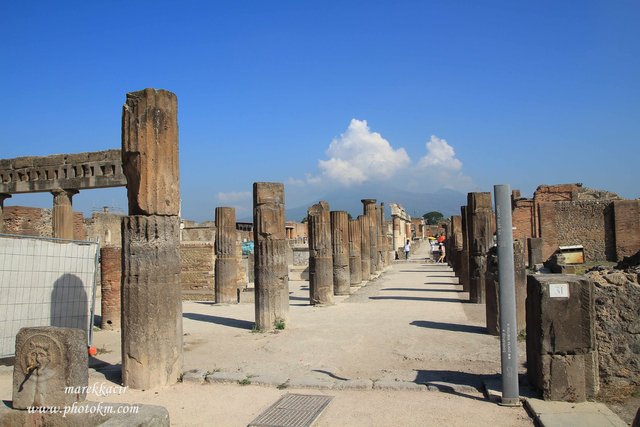
In the morning we followed the instructions to the port, where we board the ferry. A beautiful sunny day is ahead of us. Our ferry has only one stop on the way to Naples. This is the island of Procida.
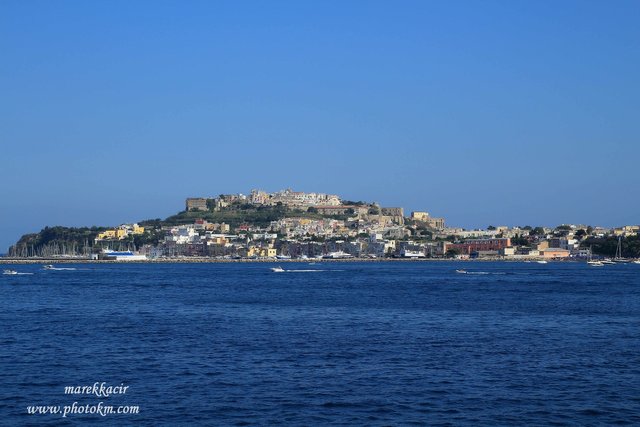
I was tempted to go see this island as well, but due to lack of time we did not succeed. Nevertheless, in addition to learning, we also wanted to swim in the sea, relax and relax.
After waiting for a while in front of the entrance gate and taking the first photos, we enter the place where time stood still. In 79, this thriving city of the Roman Empire on the shores of the Tyrrhenian Sea was hit by tragedy. The eruption of Mount Vesuvius buried him under a 4 to 6 meter layer of pumice and ash.
But let's do it gradually. After all, until the city was hit by a catastrophe, it was a cultural and social center and was of great importance in the Roman Empire and before it.
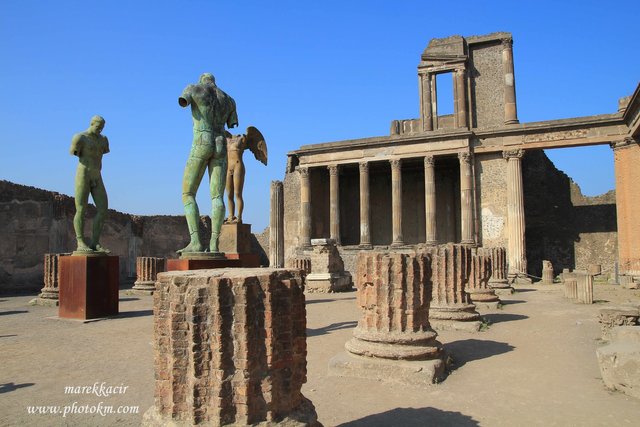
The first place we enter in the city is the Tribunal of the Basilica. Despite the fact that it was largely destroyed after the eruption, it affects me impressively. We have just started and I am already fascinated by this place.
The first traces of settlement in this place date back to 3 millennia before Christ. At the end of the 7th century BC, the Osk tribe settled here. They established a settlement here, which stretched to the foot of the volcano. They named her Gens Pompeii.
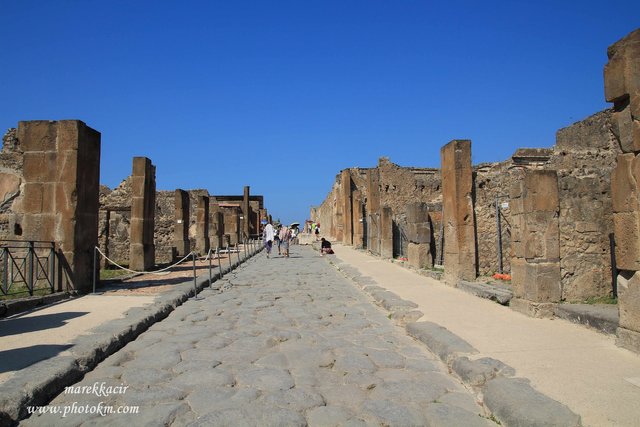
The great expansion of the city occurred when the city came under the rule of the Samnites. They focused their efforts on building the city. They gave it a rectangular urban structure, expanded the city center, built two forums with public buildings and, last but not least, built walls that protected the city. Pompeii under their rule achieved prosperity and economic prosperity.
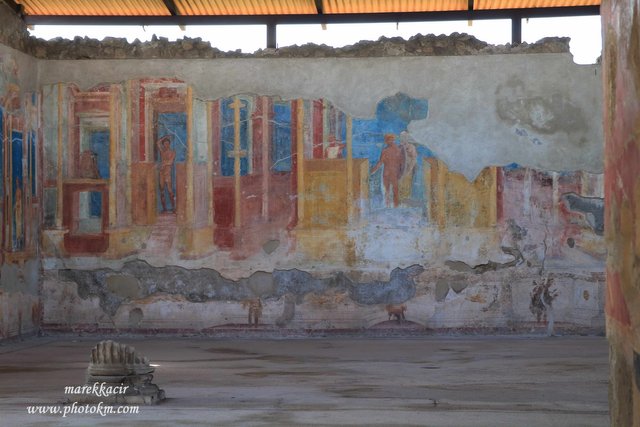
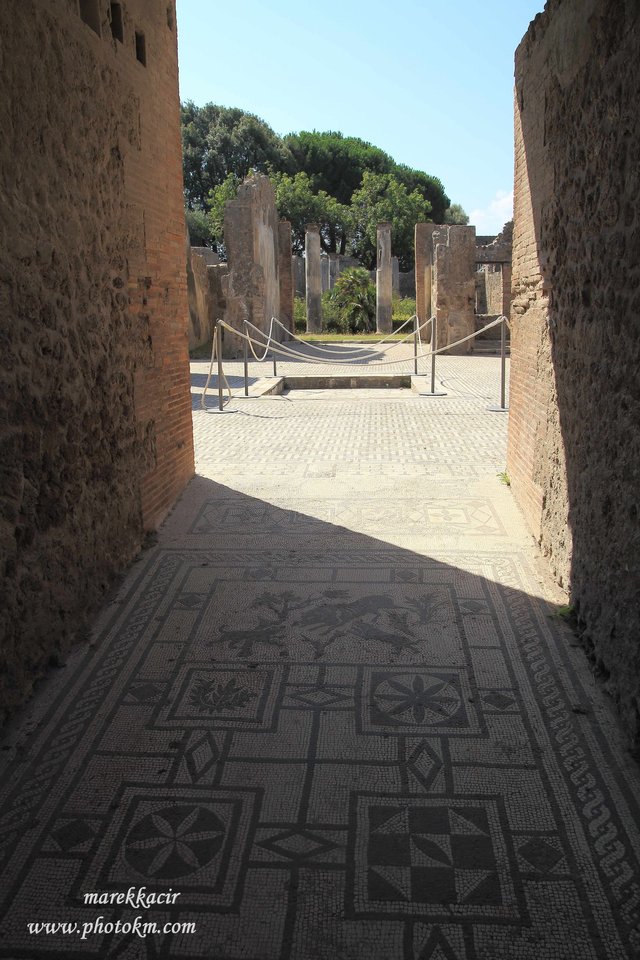
In 310 BC, they were defeated by the Romans and Pompeii became the site of military veterans. The Romans continued to develop the city. Fountains, water mains, shops were built and the city was enriched by the beautiful artistic decoration that we can see in this house.
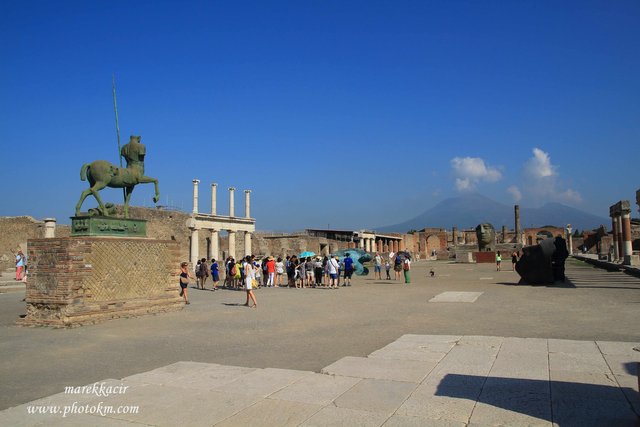
Public, religious, economic and political life took place in the main forum. Public buildings were built around the large square, which served to manage the city. The whole forum was surrounded by Doric columns.

As we walk through the alleys, we see masculine nature depicted on the corners of some buildings. I originally thought that this was how they distinguished street names or numbers, but I was wrong. Male nature indicated the location of the nearest public house. Handy marking.
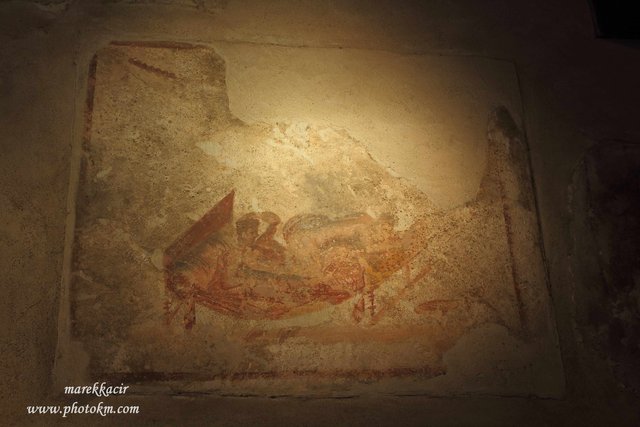
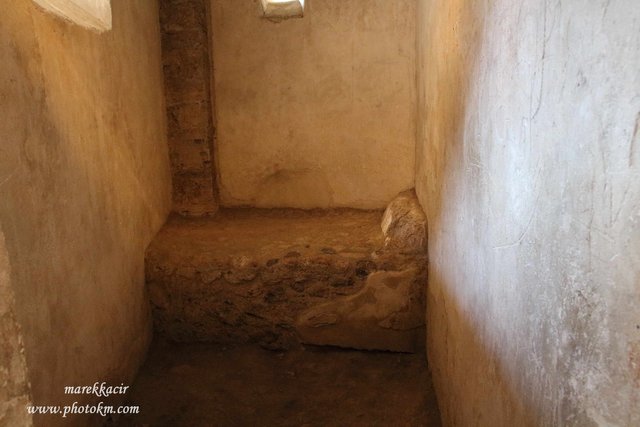
We went to look inside one of them. The decoration on the walls tells us what happened here, even if we didn't know it in advance. The decoration was supposed to evoke the right atmosphere. I must admit that the Romans enjoyed themselves.
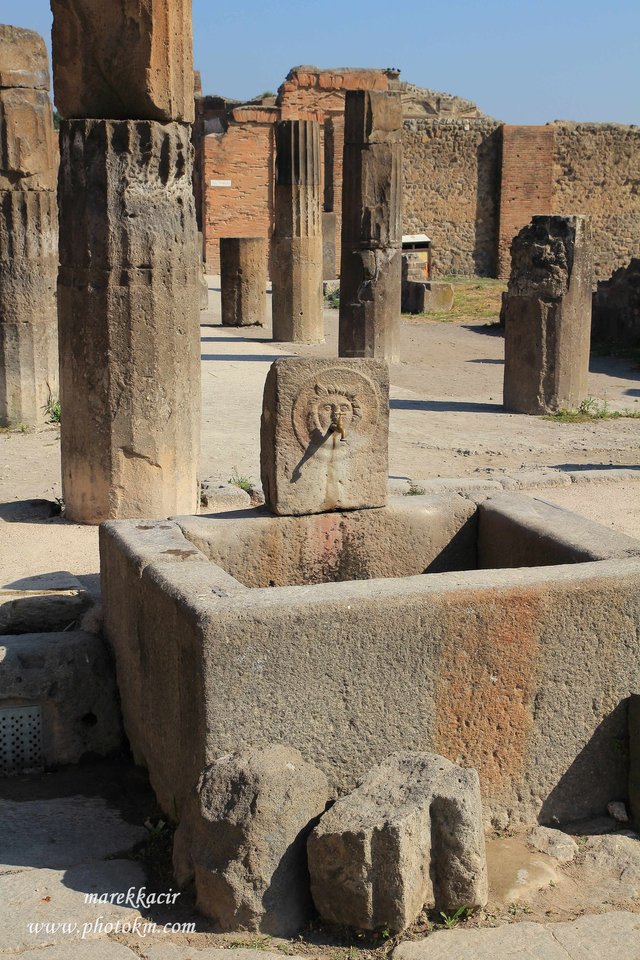
So what were the streets named? On each street, a water tank was connected to the city's water supply. Each of them had its own symbol, and according to him, the street bore its name.
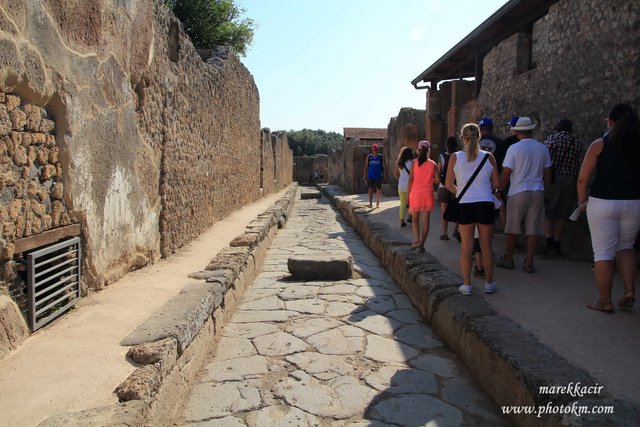
The roads are also extremely interesting, as you can see in the picture. The middle lane was used to cross cars and rainwater. People walked on the right and left side, and if they wanted to cross to the other side, they crossed the stone in the middle.
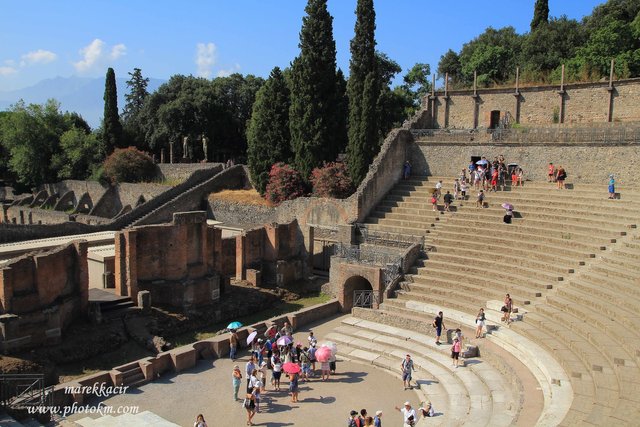
We come to the Teatro Grande. 5000 viewers came into view. I can vividly imagine sitting in the stands and watching a theatrical performance.
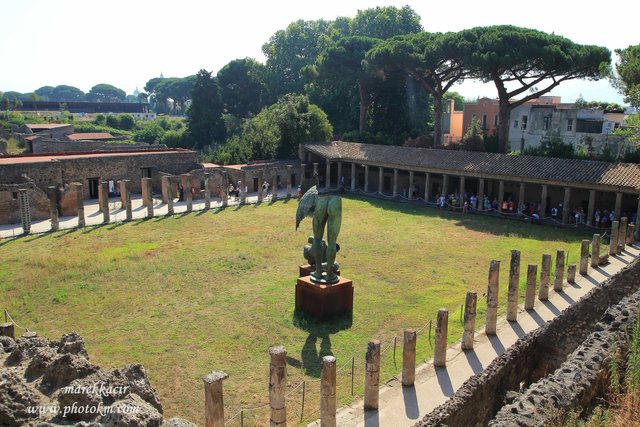
We walk through an alley, where we can cool down under the treetops, at least for a while. But not for long, because right behind it is a school of gladiators. Here the brave men trained and prepared for their life-and-death struggle.
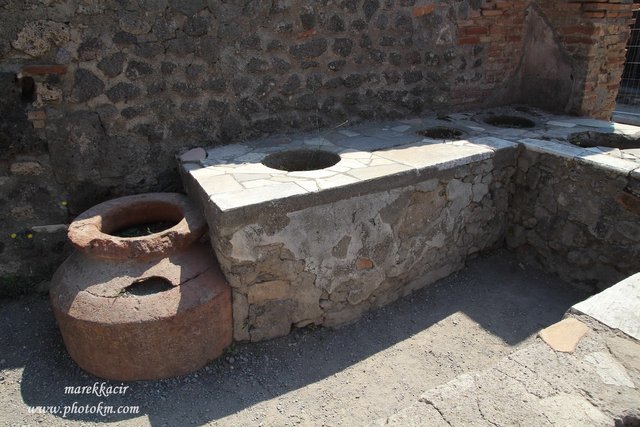
This is how the cuisine looked like in the time of Ancient Rome.
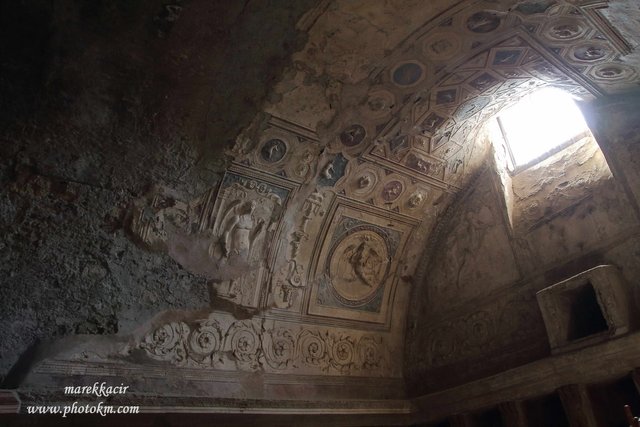
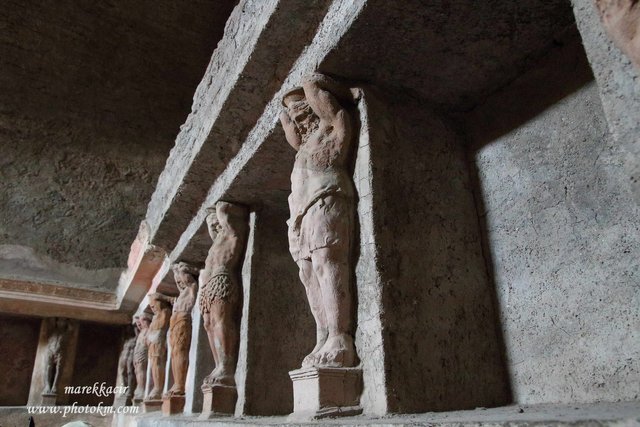
I mentioned that the Romans knew how to enjoy themselves. Not only in public houses, but also in spas like these. It amazes me how beautifully they are decorated and that the decoration has been preserved to this day. Paradoxically, we can thank the catastrophe that has befallen Pompeii.
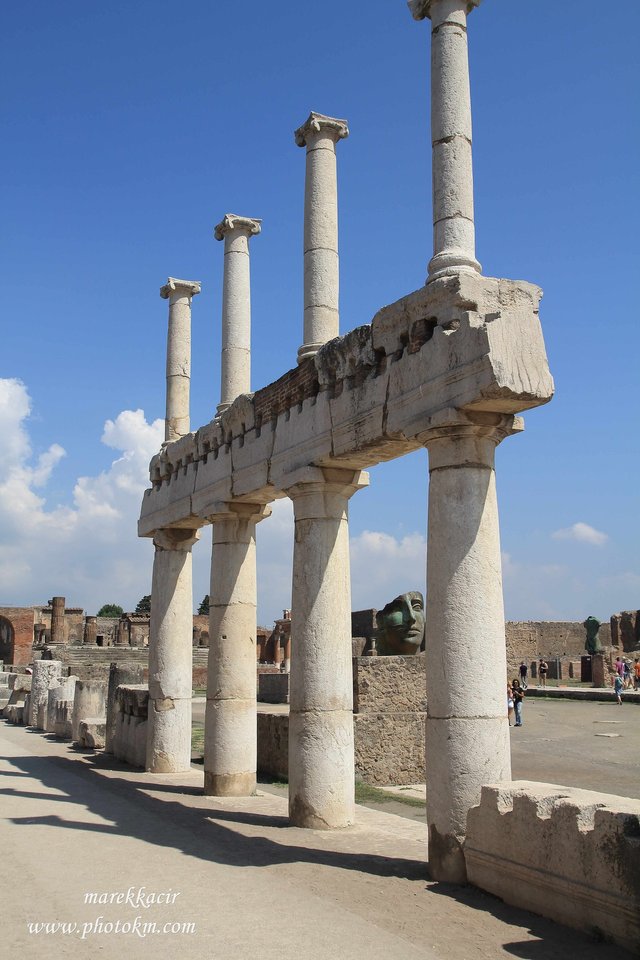
It's hot and we try to find a cool place and hide at least for a while from the rays of the sun where we can. Whether it's behind the walls of houses or behind one of the well-preserved Doric pillars.

At the end of the tour, we walk past the finds from Pompeii from which it freezes. Several castings are collected in a large room. These were created by archaeologists pouring gypsum into cavities in the ground. It froze, and when they pulled it out, they found that it was the last resting place of the people of Pompeii and their location at the time of their death. The castings show us exactly the position in which they died. In front of me I see a figure sitting and as if praying and hoping to survive this catastrophe. Next to it is a cast of a dog that hanged itself on a rope while trying to escape from the city. It made a big impression on me.
We saw Pompeii, at least some of them. In some places, excavation work is still in progress and archaeologists are finding new and new houses, objects, remains.
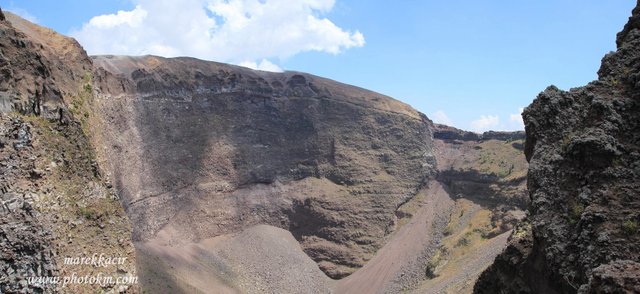
But what would it be like was to visit Pompeii and not look at the crater of the volcano that caused the destruction of the city.
In the heat we climb the steep hiking trail up. It's a dusty sidewalk. At the time of the eruption and destruction of Pompeii, Mount Vesuvius was much higher than it is now. We are grateful that the volcano is currently only 1279 meters high and we do not have to go even higher.

The volcano is still active and as it is located near the city of Naples, it is considered one of the most dangerous volcanoes. The last eruption was not so long ago, it was in 1944.
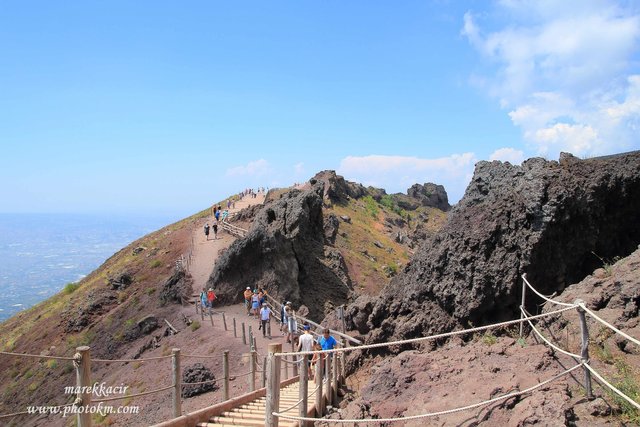
What did it actually look like in 79?
The volcano of the people of Pompeii and the surrounding area has warned before. The earthquakes in the area were nothing special, and from time to time a dark cloud appeared over the crater and ash fell on the city. People considered it the wrath of the gods, and it never occurred to them that it was about to erupt.
Various warnings preceded the eruption. Drones could be heard from the depths of the earth, and sulfur fumes escaped in various places. The animals knew what was happening and were restless. In my opinion, however, the biggest warning was that the water in the wells had dried up.
On August 24, 79, Vesuvius awoke from his sleep. A cloud of thick black smoke rose above the crater, overshadowing the sun during the white day, as if it were night. Lava began to flow out of the foothills and the volcano began spewing ash and pumice. Rain of ash, pumice and stones began to fall on the city. Many people died right on the street. Some believed that they would be able to hide in their homes. They were wrong. If they were not killed by the roof of their own house, which did not keep the burden of stones and pumice, they were killed by poisonous gases. The layer of ash and pumice was so high over time that it was no longer possible to walk the streets. Only those who managed to escape from the city in time were saved.
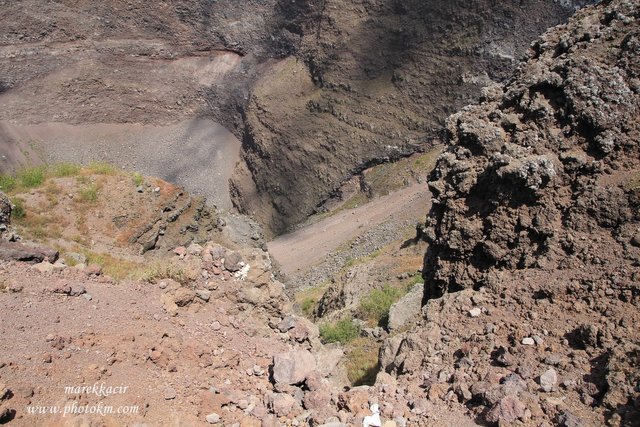
The eruption was described in detail by Pliny the Younger. Let me quote his letter to his friend Tacit. It would be a shame if I didn't list him here.
,, ... It had been a day for about an hour, but the light was still uncertain and dim. The houses around had already collapsed, and although we stood in the open but narrow space, we were very afraid of collapsing buildings. So in the end, it seemed reasonable to leave town. We were followed by a terrified crowd, which, in fear, seems cautious, forces its will on others and persecutes and pushes those who escape in great crowd ... The sea was seen, swallowed up by itself and almost pushed out by the earthquake. Surely the coast widened and many fish remained dry. On the other hand, a black and terrible cloud torn by a rapidly circling hot wind opened in long tongues of fire, they were like lightning and still more lightning ... and not much time passed, the cloud descended to the ground and hit the sea. He covered and hid Capri and hid the view of Cape Miseno ... The ashes were already falling, but not yet thick, I turn and see a thick fog hovering behind my back like a tide, scattering across the ground and chasing us ... night, not like those cloudy nights without the moonlight, but like when you're in a closed place without light. You would hear the moans of women, the cries of children, the cries of men, he sympathized with his own destiny, he with the fate of his loved ones. There were those who called her out of fear of death. Many prayed earnestly to the gods, many thought they were gone, and that night must have been the last night of the world ... ,,
Source: www.wikipedia.org
This trip was really worth it. Despite the fact that it was incredibly warm, especially in the capital city, where the heat radiated from all sides. The history of Pompeii is impressive and seeing them live is a really nice travel experience that I recommend to anyone who loves history and travel.
Po slovensky
Cestovať do Neapola a nevidieť Pompeje? To hádam ani nie je možné. Presne to sme si povedali aj my počas našej dovolenky na ostrove Ischia v Neapolskom zálive. Na tento výlet sme sa prihlásili cez taliansku cestovnú kanceláriu priamo na ostrove. V našej situácii to bolo jednoduchšie, pretože sme mali zabezpečenú cestu trajektom do Neapola a tam nás už čakal autobus smer Pompeje.
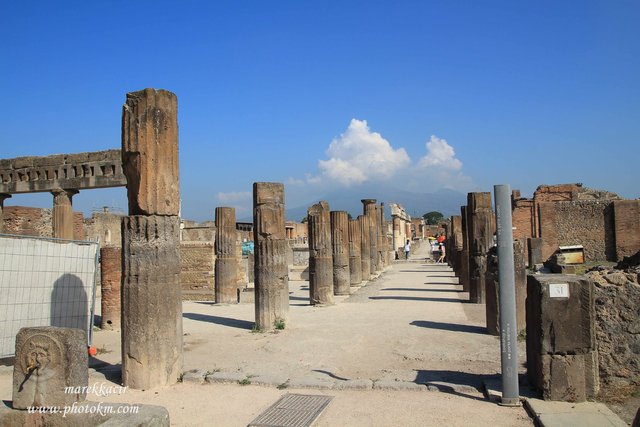
Ráno sme podľa pokynov prišli do prístavu, kde nastupujeme na trajekt. Pred nami je krásny slnečný deň. Náš trajekt má po ceste do Neapola iba jednu zastávku. Tou je ostrov Procida.
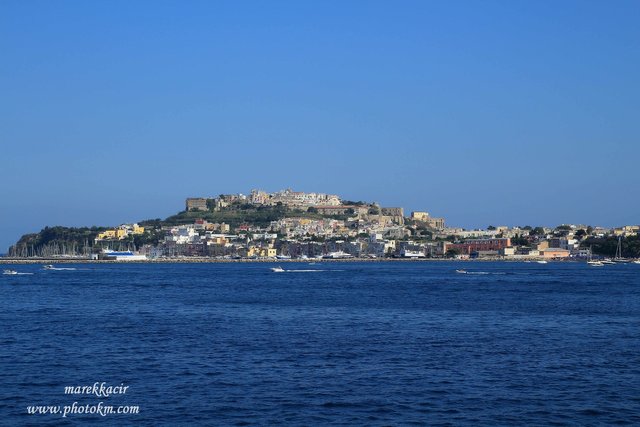
Lákalo ma ísť sa pozrieť aj na tento ostrov, no pre nedostatok času sa nám to nepodarilo. Predsa len sme sa chceli okrem poznávania aj vykúpať v mori, oddýchnuť si a zrelaxovať.
Po chvíli čakania pred vstupnou bránou a nafotení prvých fotiek vstupujeme na miesto, na ktorom sa zastavil čas. V roku 79 toto prekvitajúce mesto rímskej ríše na brehu Tyrrhenského mora postihla tragédia. Erupcia sopky Vezuv ho pochovala pod 4 až 6 metrovou vrstvou pemzy a popola.
Ale poďme na to postupne. Veď pokým mesto nepostihla katastrofa, bolo to kultúrne a spoločenské centrum a malo veľký význam v Rímskej ríši a aj pred ňou.
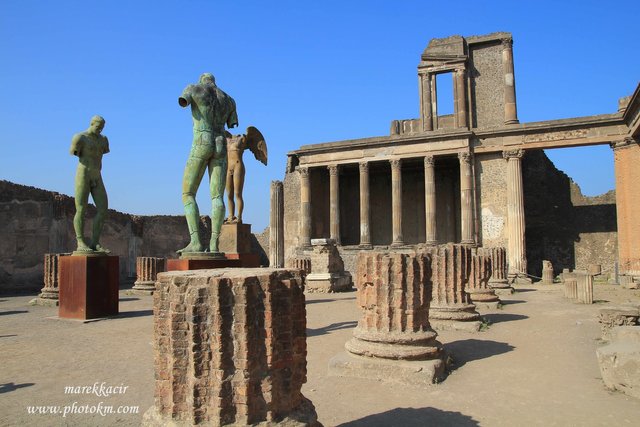
Prvé miesto do ktorého v meste vchádzame je Tribunál baziliky. Napriek tomu, že po erupcii bola z veľkej časti zničená, pôsobí na mňa impozantne. Ešte sme len začali a už som týmto miestom uchvátený.
Prvé stopy osídlenia tohto miesta pochádzajú z 3 tisícročia pred Kristom. Na konci 7 storočia pred Kristom sa tu usídlil kmeň Oskov. Tí tu založili osadu, ktorá sa tiahla až k úpätiu sopky. Pomenovali ju Gens Pompeia.
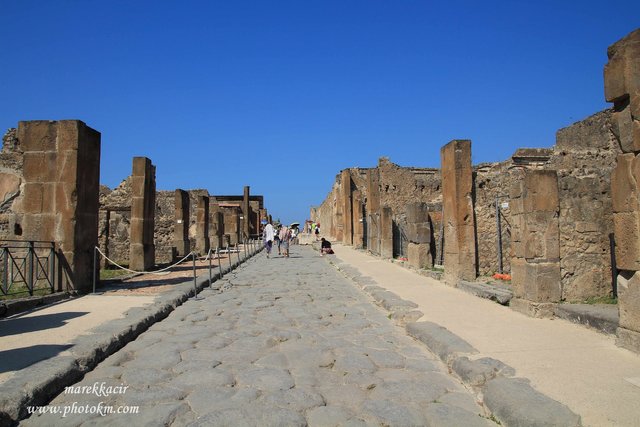
Veľký rozmach mesta nastal, keď sa mesto dostalo pod nadvládu Samnitov. Svoje úsilie zamerali na budovanie mesta. Dali mu pravouhlú urbanistickú štruktúru, rozšírili mestské jadro, postavili dve fóra s verejnými budovami a v neposlednom rade vybudovali hradby, ktoré mesto chránili. Pompeje za ich vlády dosiahli prosperitu a hospodársky rozmach.
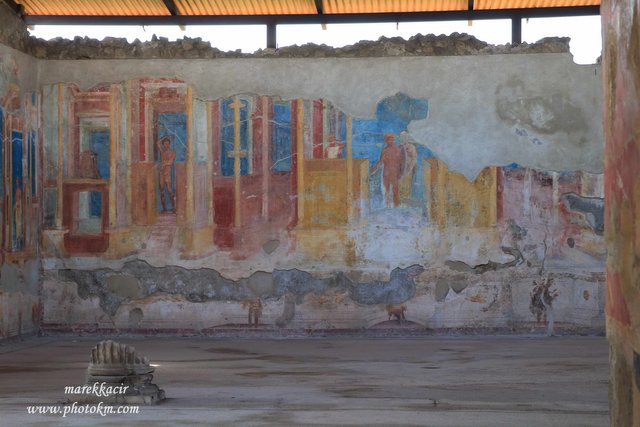
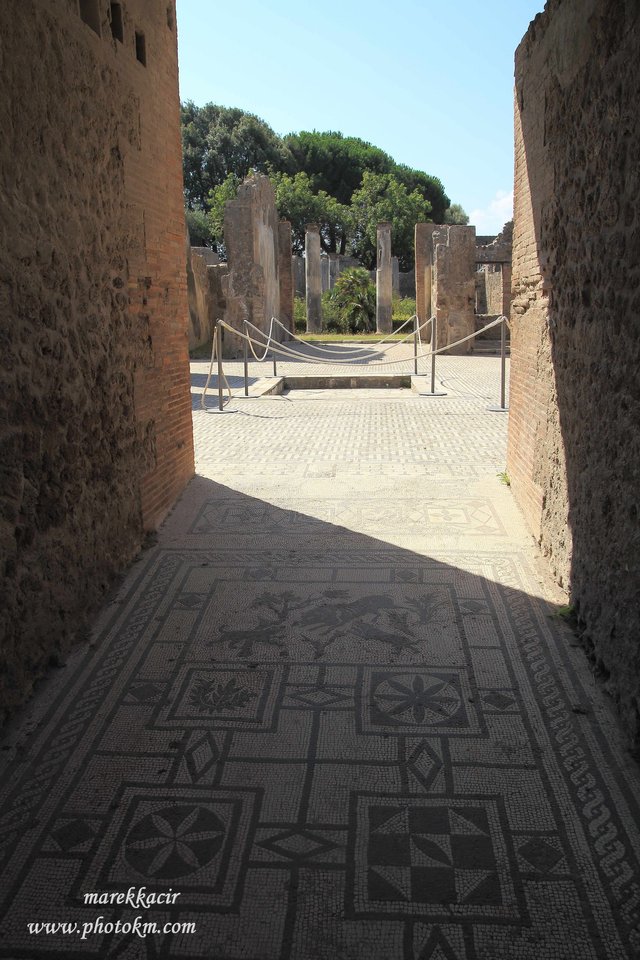
V roku 310 pred Kristom ich porazili Rimania a Pompeje sa stali miestom usídľovania vojenských veteránov. Rimania pokračovali v rozvoji mesta. Budovali sa fontány, vodovody, obchody a mesto sa obohacovalo nádhernou umeleckou výzdobou, akú môžeme vidieť v tomto dome.
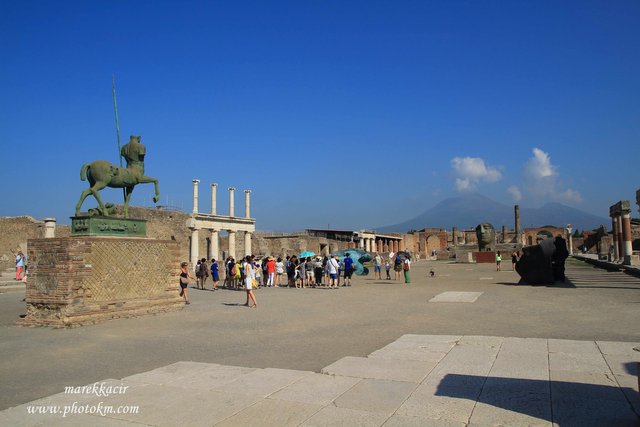
Verejný, náboženský, hospodársky a politický život sa odohrával na hlavnom fóre. Okolo veľkého námestia boli vybudované verejné budovy, ktoré slúžili na správu mesta. Celé fórum bolo obklopené dórskymi stĺpmi.
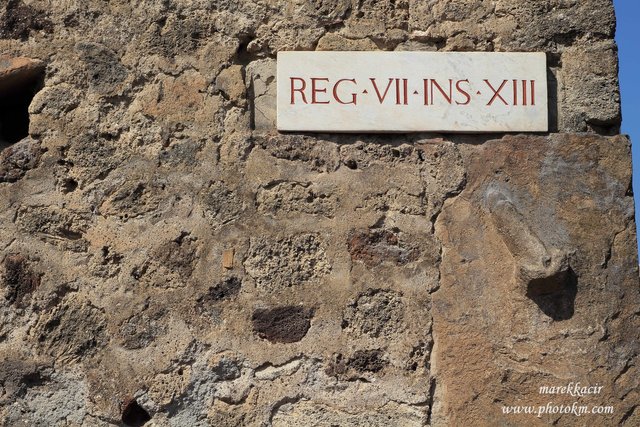
Pri prechádzaní uličkami vidíme na rohoch niektorých budov vyobrazené mužské prirodzenie. Pôvodne som si myslel že práve takto nejako rozlišovali názvy ulíc alebo čísla, no mýlil som sa. Mužské prirodzenie ukazovalo na polohu najbližšieho verejného domu. Šikovné značenie.
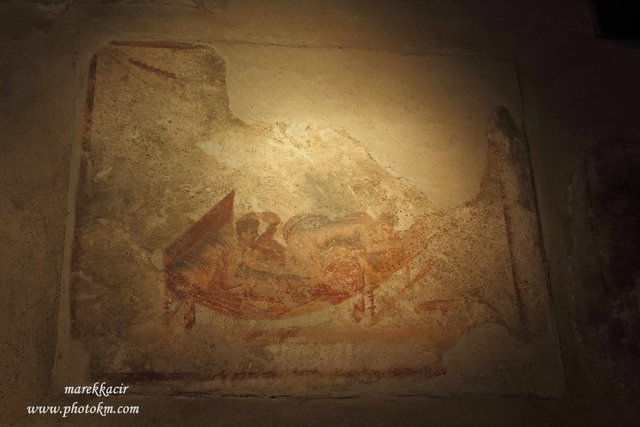
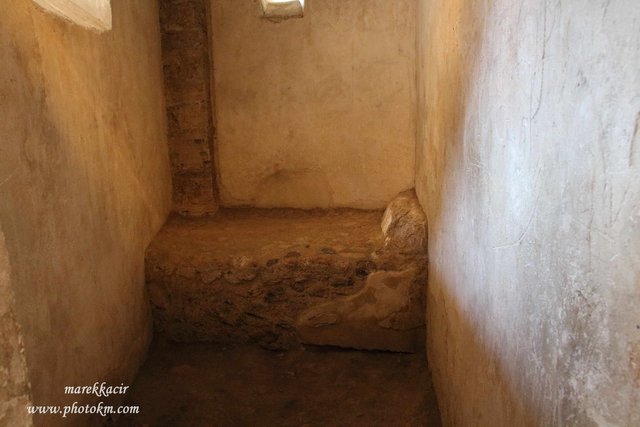
Do útrob jedného z nich sme sa išli pozrieť. Výzdoba na stenách nám prezradí čo sa tu dialo aj keby sme to nevedeli dopredu. Výzdoba mala navodiť tú správnu atmosféru. Musím uznať, že si tí Rimania poriadne užívali.
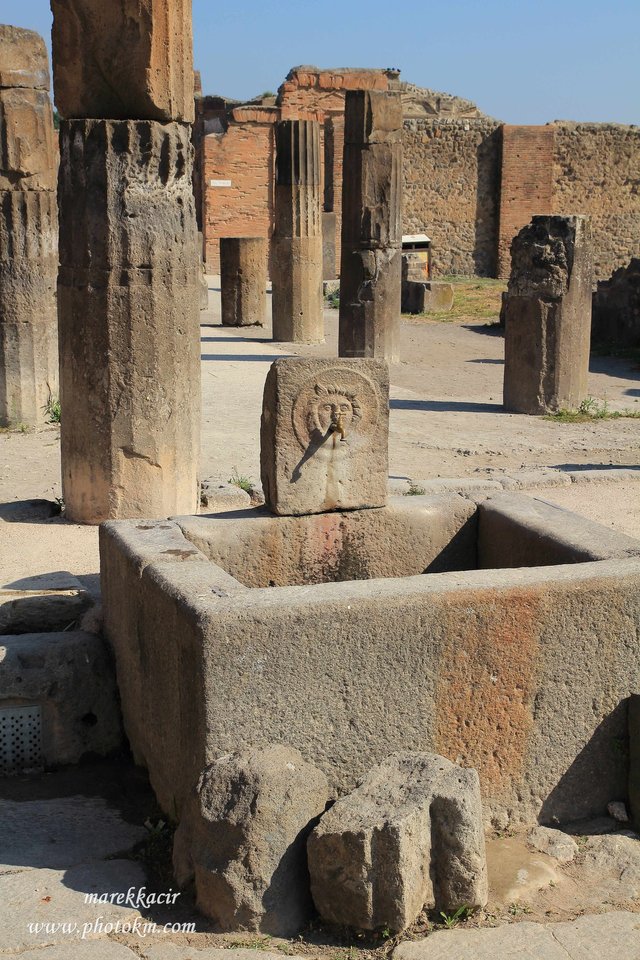
A ako teda boli pomenované ulice? Na každej ulici bola nádrž s vodou napojená na mestský vodovod. Každá z nich mala svoj vlastný symbol a práve podľa neho niesla ulica svoje meno.
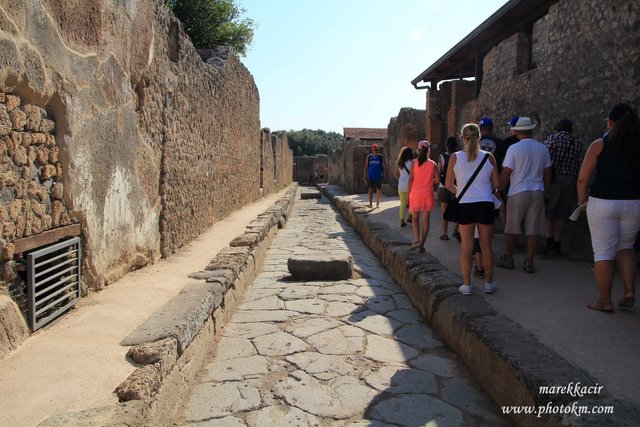
Cesty sú takisto mimoriadne zaujímavé, ako môžete vidieť na obrázku. Stredný pruh slúžil na prechod vozov a dažďovej vody. Ľudia chodili po pravej a ľavej strane a ak chceli prejsť na druhú stranu tak prešli po kameni umiestnenom v strede.
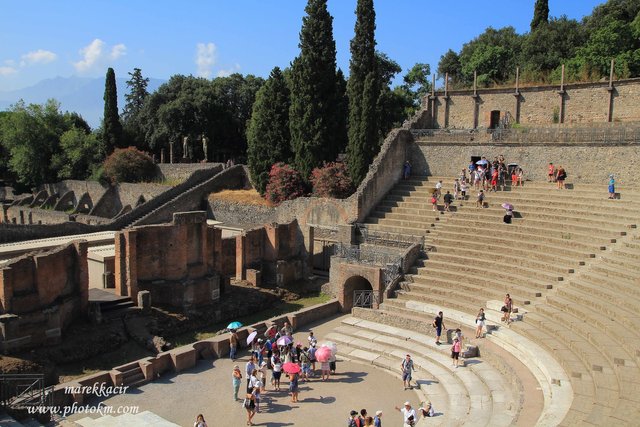
Prichádzame k divadlu Teatro Grande. Do hľadiska sa vošlo 5000 divákov. Živo si viem predstaviť ako sedím v hľadisku a sledujem nejaké divadelné predstavenie.
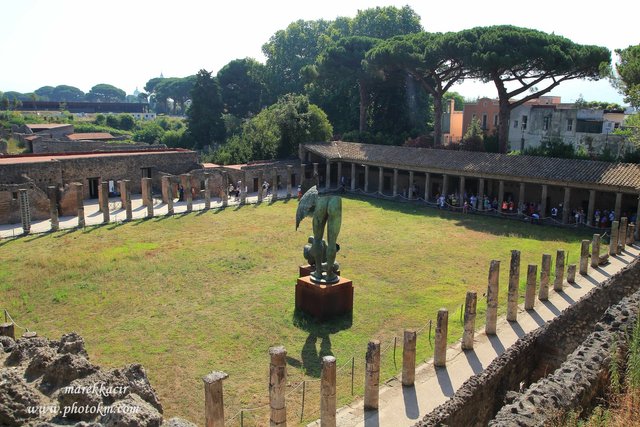
Prechádzame alejou, kde sa aspoň na chvíľu môžeme pod korunami stromov schladiť. Nie však na dlho, pretože hneď za ňou sa nachádza škola gladiátorov. Tu sa cvičili statočný muži a pripravovali sa na svoj boj na život a na smrť.
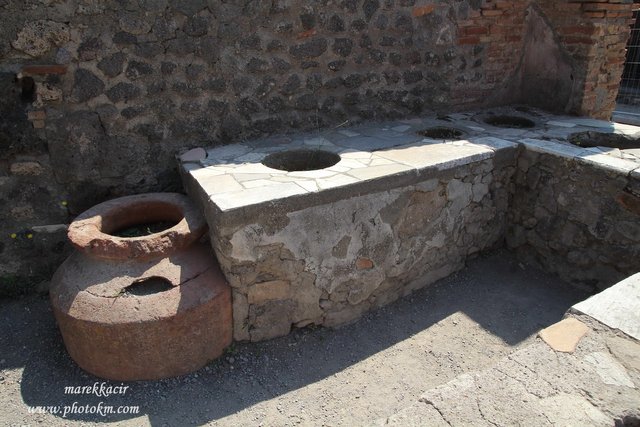
Takto nejako vyzerala kuchyňa za čias Starovekého Ríma.
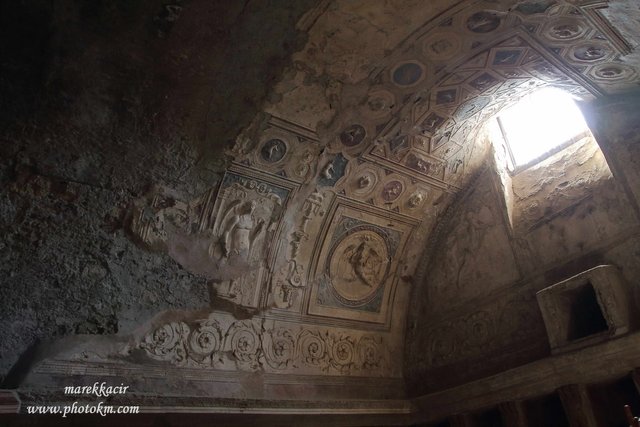
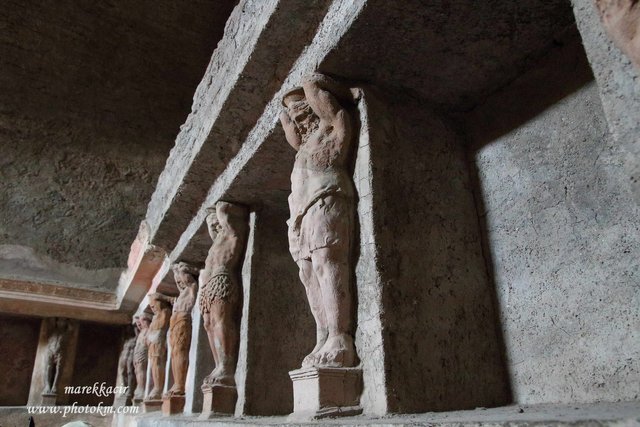
Spomínal som, že Rimania si vedeli užívať. Nie len vo verejných domoch, ale aj v kúpeľoch, ako sú tieto. Udivuje ma, ako krásne sú zdobené a že sa vôbec tá výzdoba zachovala do dnešných čias. Paradoxne tomu môžeme poďakovať katastrofe, ktorá Pompeje postihla.
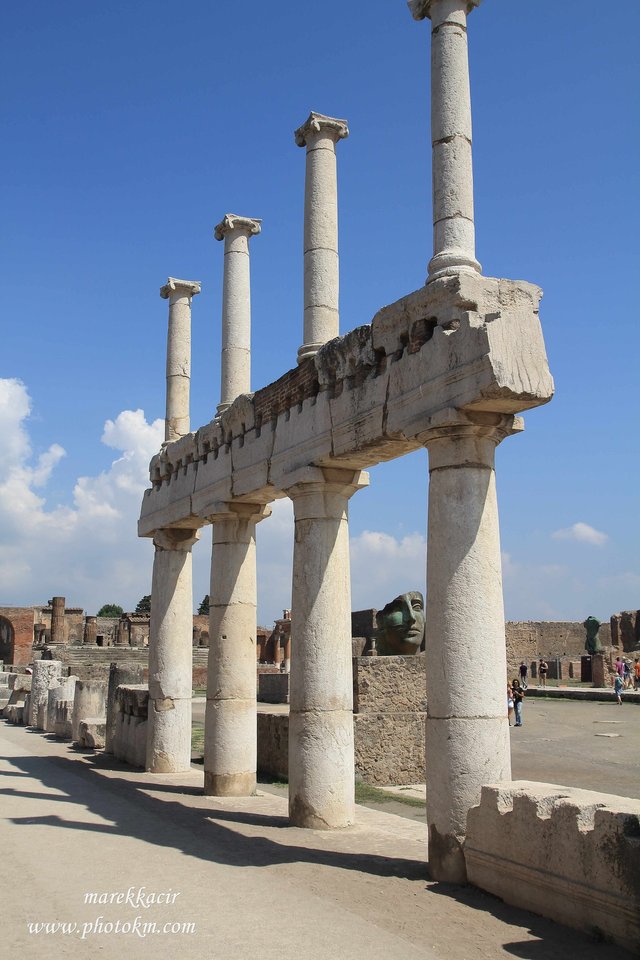
Je horúco a my sa snažíme nájsť chládok a schovať sa aspoň na chvíľu pred lúčmi slnka kde sa len dá. Či už je to za múrmi domov, alebo za niektorým zo zachovalých dórskych stĺpov.
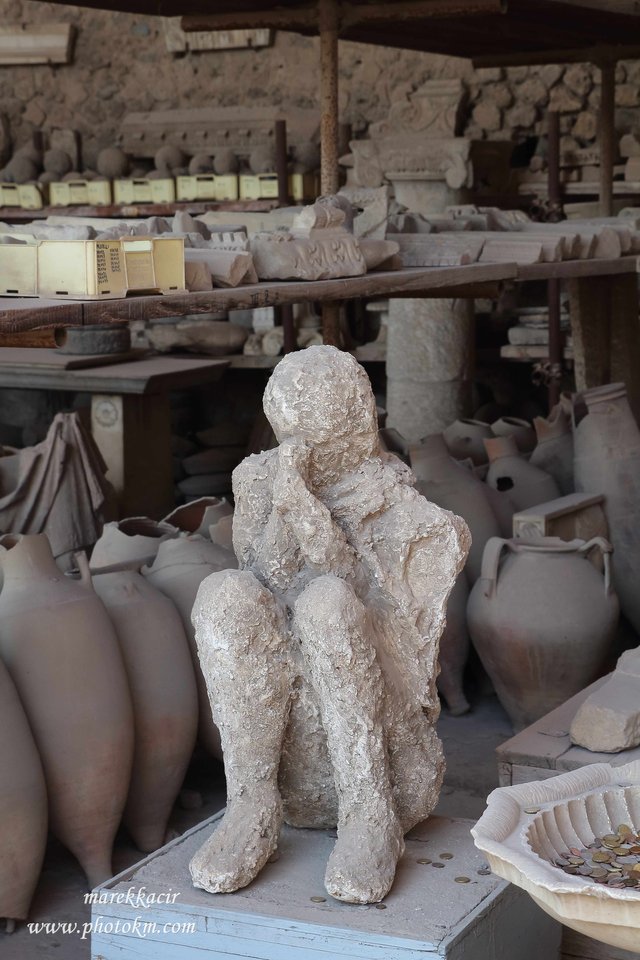
Na záver prehliadky prechádzame okolo nálezov z Pompejí z ktorých mrazí. Vo veľkej miestnosti je zhromaždených niekoľko odliatkov. Tie vznikli tak, že do dutín v zemi archeológovia naliali sadru. Tá stuhla a keď ju vytiahli tak zistili že sa jedná o miesto posledného odpočinku obyvateľov Pompejí a ich polohy, v čase ich smrti. Odliatky nám presne ukazujú v akej polohe zomreli. Pred sebou vidím postavu ktorá sedí a akoby sa modlila a dúfala, že túto katastrofu prežije. Vedľa nej je odliatok psa, ktorý sa obesil na lane pri pokuse ujsť z mesta. Zanechalo to vo mne veľký dojem.
Pompeje sme videli, teda aspoň časť z nich. Na niektorých miestach ešte stále prebiehajú výkopové práce a archeológovia nachádzajú nové a nové domy, predmety, pozostatky.
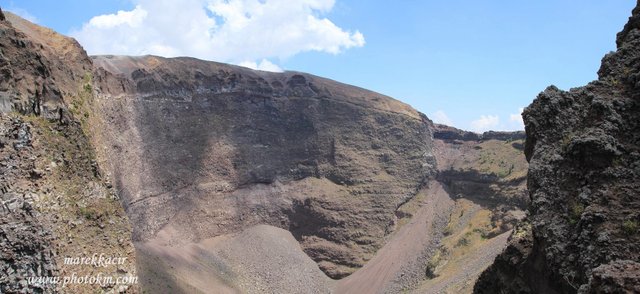
Ale aké by to bolo navštíviť Pompeje a nepozrieť sa do krátera sopky, ktorá skazu mesta zapríčinila.
V horúčave stúpame strmým turistickým chodníkom hore. Je to prašný chodník. V čase erupcie a zničenia Pompejí, bol Vezuv omnoho vyšší ako teraz. Sme vďačný, že v súčasnosti je sopka vysoká iba 1279 metrov a nemusíme ísť ešte vyššie.

Sopka je stále činná a nakoľko sa nachádza v blízkosti mesta Neapol, je považovaná za jednu z najnebezpečnejších sopiek. Posledná erupcia nebola až tak dávno, bola v roku 1944.
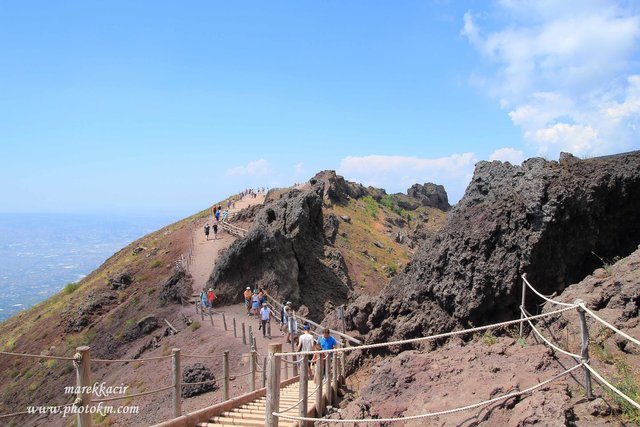
Ako to vlastne vyzeralo v roku 79?
Sopka obyvateľov Pompejí a okolia varovala už predtým. Zemetrasenia v oblasti neboli ničím výnimočným a z času na čas sa nad kráterom objavoval tmavý mrak a na mesto padal popol. Ľudia to považovali za hnev bohov a ani ich nenapadlo, že sa schyľuje k erupcii.
Priamo erupcii predchádzali rôzne varovania. Z hlbín zeme bolo počuť hukot, na rôznych miestach unikali sírne výpary. Zvieratá tušili čo sa deje a boli nepokojné. Podľa mňa však najväčšie varovanie bolo to, že v studniach vyschla voda.
24 augusta 79 sa Vezuv prebudil zo spánku. Nad kráterom sa vzniesol mrak hustého čierneho dymu, ktorý počas bieleho dňa zatienil slnko, akoby bola noc. Po úpätí začala vytekať láva a sopka začala chrliť popol a pemzu. Dážď popola, pemzy a kameňov začal padať na mesto. Mnoho ľudí zahynulo priamo na ulici. Niektorí verili, že sa im podarí ukryť vo svojich domovoch. Mýlili sa. Ak ich nezabila strecha ich vlastného domu, ktorá neudržala ťarchu kameňov a pemzy, tak ich zabili jedovaté plyny. Vrstva popola a pemzy bola po čase taká vysoká, že sa po uliciach už nedalo chodiť. Zachránili sa iba tí, ktorým sa podarilo zavčasu z mesta ujsť.
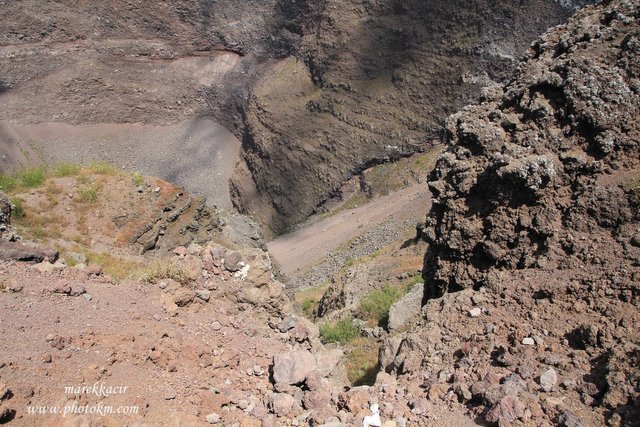
Erupciu podrobne opísal Plínius Mladší. Dovolím si citovať jeho list, ktorý poslal svojmu priateľovi Tacitovi. Bola by škoda keby som ho tu neuviedol.
,,...Už asi hodinu bol deň, no napriek tomu svetlo bolo neurčité a ďalej slablo. Už sa zrútili domy okolo a hoci sme stáli na otvorenom, no úzkom priestranstve, mali sme veľký strach z rúcajúcich sa budov. Nakoniec sa nám teda zdalo rozumné odísť z mesta. Nasledoval nás vydesený dav, ktorý , ako sa to v strachu zdá byť opatrnosťou, vnucuje svoju vôľu iným a vo veľkom húfe prenasleduje a tlačí tých, čo unikajú... Bolo vidieť more, pohltené samo sebou a takmer vytlačené zemetrasením. Zaiste sa pobrežie rozšírili a mnoho rýb ostalo na suchu, Na druhej strane sa čierny a strašný mrak potrhaný rýchlym krúžením rozpáleného vetra otváral v dlhých ohnivých jazykoch, boli ako blesky a stále ďalšie blesky... a ani neprešlo veľa času, oblak zostúpil na zem a zasiahol more. Zahalil a skryl Capri a ukryl výhľad na mys Miseno... Už padal popol, nie však ešte hustý, obrátim sa a vidím, ako sa za mojím chrbtom vznáša hustá hmla ako akýsi príval, rozptyľujúc sa po zemi a prenasledujúc nás... Prichádza noc, nie taká z tých oblačných nocí bez svitu mesiaca, ale ako keď si na uzatvorenom mieste bez svetla. Bol by si počul stony žien, krik detí, výkriky mužov, ten súcitil so svojím vlastným osudom, tamten s osudom svojich blízkych. Boli takí, čo zo strachu zo smrti ju privolávali. Mnohí sa úpenlivo modlili k bohom, mnohí súdili, že už ich niet a tá noc musela byť poslednou nocou sveta...,,
Zdroj: www.wikipedia.org
Tento výlet stál skutočne za to. Napriek tomu, že bolo neskutočne teplo, hlavne v mamennom meste, kde teplo sálalo z každej strany. História Pompejí je impozantná a vidieť ich naživo je naozaj veľmi pekný cestovateľský zážitok, ktorý odporúčam každému kto má rád históriu a cestovanie.
Congratulations @photoparadise! You received the biggest smile and some love from TravelFeed! Keep up the amazing blog. 😍 Your post was also chosen as top pick of the day and is now featured on the TravelFeed.io front page.
Thanks for using TravelFeed!
@smeralda (TravelFeed team)
PS: Did you know that we recently launched the truvvl app? With truvvl, you can create travel stories on the go from your phone and swipe through nearby stories from other TravelFeed users. It is available on the Apple App Store and Google Play.